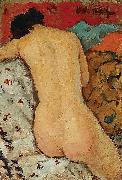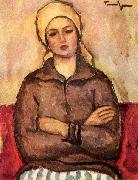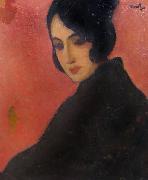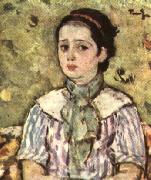|
||||||||||
|
|
||||||||||
|
Naked Gemälde ID:: 76838 Siehe Galerie in Schweden |
Naked Nud în iatac, ulei pe carton, 34x24 cm, semnat dreapta sus, cu brun, Tonitza cyf Nud_în_iatac,_ulei_pe_carton,_34x24_cm,_semnat_dreapta_sus,_cu_brun,_Tonitza cyf |
|||||||||
|
|
||||||||||
|
Muncitoare Gemälde ID:: 76849 Siehe Galerie in Schweden |
Muncitoare Oil on cardboard, 0.500 x 0.400. Dr. N. I. Dona Collection cyf Oil_on_cardboard,_0.500_x_0.400._Dr._N._I._Dona_Collection cyf |
|||||||||
|
|
||||||||||
|
Spaniola Gemälde ID:: 77523 Siehe Galerie in Schweden |
Spaniola Spaniola ("The Spanish Woman"), oil on cardboard, 55 x 45 cm. 1927-1928 cjr Spaniola_("The_Spanish_Woman"),_oil_on_cardboard,_55_x_45_cm._ _1927-1928 _ cjr |
|||||||||
|
|
||||||||||
|
Self-portrait. Oil on cardboard, 0.410 x 0.360. Gemälde ID:: 77827 Siehe Galerie in Schweden |
Self-portrait. Oil on cardboard, 0.410 x 0.360. c. 1923 cjr c._1923 cjr |
|||||||||
|
|
||||||||||
|
Irina Gemälde ID:: 77925 Siehe Galerie in Schweden |
Irina oil on canvass, 0.600 x 0.500 Date 1926-1927 cyf oil_on_canvass,_0.600_x_0.500 _ Date_1926-1927 _ cyf |
|||||||||
|
|
||||||||||
| Vorheriger Künstler Nächster Künstler | ||||||||||
|
|
||||||||||
| Nicolae Tonitza | ||||||||||
| (Romanian pronunciation: [nikoˈla.e toˈnit͡sa]; April 13, 1886 - February 27, 1940) was a Romanian painter, engraver, lithographer, journalist and art critic. Drawing inspiration from Post-impressionism and Expressionism, he had a major role in introducing modernist guidelines to local art. Born in Bârlad, he left his home town in 1902 in order to attend the Iaşi National School of Fine Arts, where he had among his teachers Gheorghe Popovici and Emanoil Bardasare.The following year he visited Italy together with University of Bucharest students of archeology under the direction of Grigore Tocilescu.During that period, together with some of his fellow students, Tonitza painted the walls of Grozeşti church. In 1908 he left for Munich, where he attended the Royal Academy of Fine Arts; he began publishing political cartoons in Furnica, and contributing art criticism articles to Arta Română. Tonitza spent the following three years in Paris, where he visited artists' studios, and studied famous paintings.Although the young artist's creation would initially conform to the prevalent style, his gift for colour and his personal touch would eventually lead him towards experiment.Throughout his life, he remained committed to the Munich School, hailing its innovative style over the supposedly "obscure imitators of Matisse". | ||||||||||
|
|
||||||||||
IntoFineArt Co,.Ltd.














